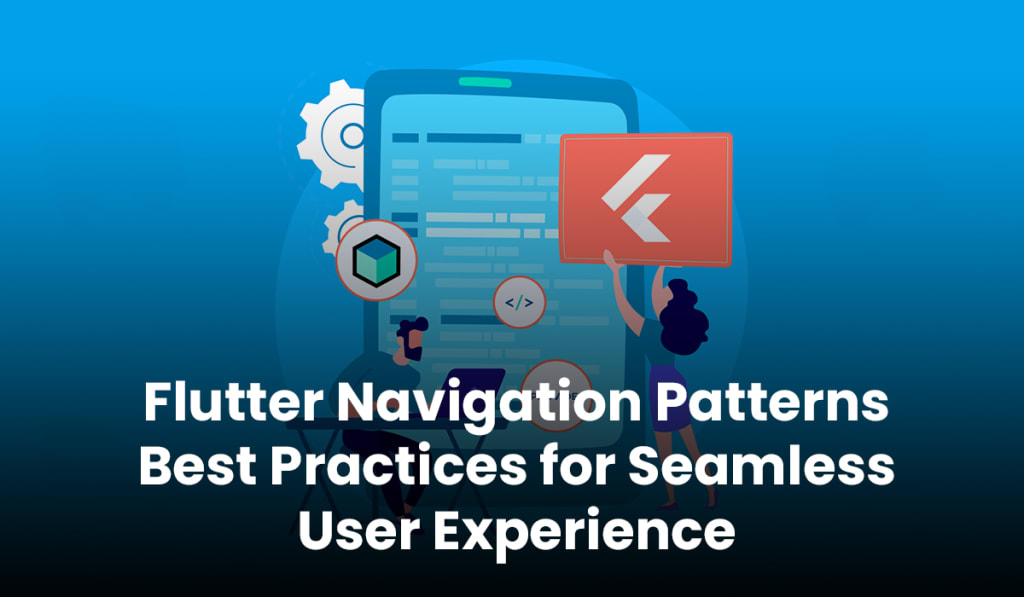Flutter Navigation Patterns: Best Practices for Seamless User Experience
Flutter Navigation Patterns for a Seamless User Experience

In the realm of mobile app development, creating a seamless and intuitive user experience is paramount. Flutter, Google's open-source UI software development toolkit, has gained popularity for its cross-platform capabilities and expressive user interfaces. Central to delivering a delightful user experience is the implementation of effective navigation patterns. In this article, we will explore Flutter navigation patterns, unveiling best practices that ensure users smoothly traverse through your app.
1. Understanding the Navigation Stack: A Fundamental Concept
Before delving into specific navigation patterns, it's crucial to understand the navigation stack in Flutter. Flutter manages a stack of "routes," where each route represents a screen or page in the app. Navigating between screens involves pushing and popping routes from this stack.
Pushing Routes: When a user moves from one screen to another, a new route is pushed onto the navigation stack.
Popping Routes: Returning to the previous screen involves popping the current route from the stack.
2. Clear and Consistent Navigation: User-Friendly Journey
The foundation of a seamless user experience lies in clear and consistent navigation. Establish a navigational structure that users can quickly grasp, ensuring that common actions follow predictable patterns. This predictability enhances user confidence and reduces the learning curve.
Bottom Navigation Bar: For apps with distinct sections or features, a bottom navigation bar with clearly labeled icons provides a straightforward way for users to switch between primary destinations.
Drawer Navigation: Utilize a drawer menu for less frequently accessed options or settings. This hidden menu can be revealed with a swipe or a button press, maintaining a clutter-free main interface.
3. Hero Animations: Elevating Visual Continuity
Flutter's Hero animations add a touch of elegance to navigation by seamlessly transitioning shared elements between screens. When a widget marked as a Hero transitions from one screen to another, Flutter automatically animates the transition, providing a visually pleasing and cohesive experience.
For example, consider using Hero animations for transitioning product images from a list to a detailed view. The smooth transition enhances the sense of continuity, making the app feel polished and refined.
4. TabBar and TabBarView: Organizing Content Effectively
When dealing with content that can be logically grouped, Flutter's TabBar and TabBarView widgets come into play. Implementing a tabbed interface allows users to switch between different sections or categories without navigating away from the main screen.
For instance, an e-commerce app might use tabs for "New Arrivals," "Best Sellers," and "Clearance," offering users quick access to specific product categories.
5. Nested Navigation: Managing Complex Hierarchies
In scenarios where your app has complex hierarchies, consider employing nested navigation structures. Flutter's Navigator class allows for the creation of independent navigation stacks within a single screen.
This is particularly useful when dealing with features like user profiles, where the user might navigate between different sections without affecting the main navigation stack.
6. On-boarding and Authentication Flows: Guiding Users Effectively
On-boarding and authentication are critical aspects of user journeys, often requiring distinct navigation patterns. Create dedicated routes for on-boarding screens, guiding users through initial setup or feature introductions.
Implement secure and user-friendly authentication flows, ensuring a smooth transition between login, registration, and the main app experience. Keep users informed about their progress and provide clear paths to return to the main content, suggests Flutter application developers in Bangalore.
7. Named Routes: Enhancing Readability and Maintainability
In larger applications, managing routes can become complex. Flutter's named routes offer a solution by assigning a unique name to each route, making the code more readable and maintainable. Named routes also facilitate navigation without the need to instantiate the destination screen directly.
By defining routes with meaningful names, developers can easily navigate to different screens using Navigator.pushNamed(context, 'routeName').
8. Deep Linking: Connecting Users to Specific Content
Deep linking enables users to navigate directly to specific content within your app, bypassing the typical navigation flow. This is particularly valuable for marketing campaigns, notifications, or sharing content externally.
Implement deep linking to ensure that users are directed to the exact screen or content relevant to the link they clicked, providing a seamless experience.
9. State Management: Preserving State Across Screens
Maintaining state across navigation transitions is crucial for a consistent user experience. Flutter provides various state management solutions, such as Provider, Riverpod, or Bloc, to ensure that the app retains important data as users navigate between screens.
By adopting effective state management practices, you prevent data loss and maintain a seamless flow even in complex applications.
10. Testing Navigation: Ensuring Reliability
Thoroughly test your app's navigation to identify and resolve potential issues before releasing it to users. Utilize Flutter's testing framework to create unit tests for navigation-related functions, ensuring that routes are pushed and popped as expected.
Additionally, conduct widget tests to verify that the UI responds correctly to user interactions, delivering a reliable and bug-free navigation experience.
Conclusion
In the realm of Flutter app development, navigation patterns are the threads that weave a user's journey. By embracing clear and consistent navigation, leveraging animations for visual continuity, organizing content effectively, and incorporating advanced features like deep linking and state management, you can craft an app that not only looks appealing but also offers a truly seamless and delightful user experience.
Flutter's versatility empowers developers to implement navigation patterns that align with the app's purpose and user expectations. As you embark on the journey of Flutter development, remember that navigation is not just about moving between screens; it's about guiding users on a smooth and enjoyable exploration of your app's capabilities. With these best practices, you can navigate brilliance, creating Flutter apps that leave a lasting impression on users and set new standards for user experience excellence.
About the Creator
Manoj Shukla
Tech Geek, Learner, and Web Designer






Comments
There are no comments for this story
Be the first to respond and start the conversation.